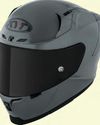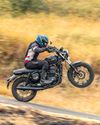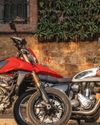
All it took was for someone to say, ‘Sorry, which pilen?’ And then followed two days of suffixing ‘pilen’ to any hapless word that came to mind, appropriate and otherwise. However, any curious onlookers tended to ignore our simple-minded laughter and instead focus on the two striking motorcycles among us, and the new name on the shapely protrusions of their tanks — Husqvarna. New, that is, for India; that badge’s history goes back to 1689 (yup), a period when people’s idea of a good time was shooting at each other, and the Husqvarna logo is still a stylised gun sight. However, the Swedish company began making motorcycles in 1903 and 117 years later on a beach, instead of dodging bullets, we were sliding around on the first two-wheeled arrows for India, the Svartpilen 250 and the Vitpilen 250.
Despite the name’s positively archaic history, the bikes are anything but old-fashioned. Along with KTM and Gas Gas, Husqvarna is owned by Pierer Mobility AG; you could see it as the group’s ‘heritage brand’, and with different core philosophies split via shared architectures, you get three fun motorcycles instead of one — a Bajaj, a KTM and a Husqvarna, the latter two penned by Kiska Design, and all made in India by Bajaj, of course. Those crankcase covers probably suffer from multiple identity crises at once. But there’s no mistaking the neocool Svartpilen (Swedish for ‘black arrow’) and the Vitpilen (‘white arrow’) for anything else.
Denne historien er fra September 2020-utgaven av Motoring World.
Start din 7-dagers gratis prøveperiode på Magzter GOLD for å få tilgang til tusenvis av utvalgte premiumhistorier og 9000+ magasiner og aviser.
Allerede abonnent ? Logg på
Denne historien er fra September 2020-utgaven av Motoring World.
Start din 7-dagers gratis prøveperiode på Magzter GOLD for å få tilgang til tusenvis av utvalgte premiumhistorier og 9000+ magasiner og aviser.
Allerede abonnent? Logg på

STRIKE HARD!
The KYT Striker lands a tough blow in the entry-level helmet segment in India

SHUTTER SPEED
Performance benchmarks from the Y2K era get together for 36 frames of action

OLD FLAMES
They say that getting old isn't for the faint of heart.

SPEED OF LIGHT
Three of the sportiest 125cc motorcycles go head to head for all the glory

QUESTION IT ALL
Everyone has an answer, but what's the right question?

SINGLE DOUBT
In a world that goes gaga over multi-cylinder engines, these singles will steal your heart

HYBRID HAVOC
The Lexus RX 500h F Sport breaks away from the mould, with its bold styling and sport-tuned performance

LIGHT SPEED
BMW’s new luxury EV sedan has supercar-level performance. Naturally, we had to go out and experience it

V8 WHAT?
We test the world's most powerful 2.0-litre engine to see if it can truly replace a V8

NEWFOUND DZIRE
Smarter, safer, and loaded with features, the new Dzire is ready to remind us why it's ruled the segment for ages